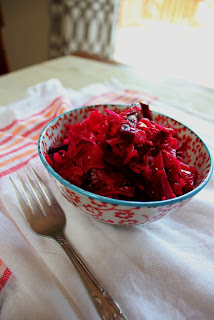for the crust:
2 1/4 tsp yeast
1 cup warm water
1 tsp raw honey
pinch salt
rosemary olive oil
2 1/2 - 3 1/2 spelt flour
1/2 cup multi grain rolled oats
cornmeal for dusting
for the pizza:
(1) small bunch arugula
3 small new potatoes thinly sliced (paper thin)
pinch of red pepper flakes
rosemary olive oil
kosher salt
honey
In a medium bowl combine yeast and warm water (120 degrees). Preheat over to 450. Set pizza stone in the oven to allow the stone to preheat. Allow yeast to sit for about 5 minutes, until frothy/bubbly. Add salt, olive oil & honey. With a wooden spoon gently stir in 2 cups of flour 1 cup at a time & oats. Turn dough out on a lightly floured clean surface. Knead remaining flour in a 1/4 cup at a time to prevent hands from sticking to the dough and dough from the work surface, knead for 10 minutes or until dough is smooth and elastic. Return to a clean bowl, oiled with olive oil. Cover and allow to rise for 30 minutes or until double in size. Divide dough into 2 equal portions if making the 8" pizzas - store the unused dough (if saving) in a ziploc gallon bag and store in fridge for up to a week. On a piece of parchment paper sprinkled with cornmeal. Hand stretch or roll the dough out with a rolling pin to an 8" diameter- perfection is not what you are looking for- it is suppose to look homemade. Roll up the sides of the dough to create a crust. Drizzle the dough with rosemary olive oil, layer the potatoes, overlapping each slightly. Sprinkle with a generous amount of salt & sprinkle with crushed red pepper flakes. Drizzle with honey and a bit more olive oil with olive oil spray, spray the crust /edges of pizza. Transfer pizza and parchment paper directly onto the pizza stone that is pre-heated in your oven. Bake for 10-12 minutes until edges are lightly browned and the potatoes are cooked through
remove from oven, allow to cool for 2 minutes,top with arugula, slice and enjoy!
Source












